How to Build a GLP Bioanalytical Lab
LCGC North America
October 2006. This month's "MS - The Practical Art" will interest those starting a new good laboratory practices (GLP) bioanalytical laboratory, reassessing an existing lab, or revamping a "spirit-of-GLP" laboratory to full GLP status.
This month's "MS — The Practical Art" will interest those starting a new good laboratory practices (GLP) bioanalytical laboratory, reassessing an existing laboratory, or revamping a "spirit-of-GLP" laboratory to full GLP status. Historically, mass spectrometers have been used largely in drug discovery owing to their qualitative capabilities and have escaped rigorous regulation. This is clearly no longer the case. Mass spectrometers are used increasingly as primary detectors in all facets of operations, which led to a column in 2004 exploring the changing nature of validation: "Taming the Regulatory Beast: Regulation Versus Functionalism" (1).
Many firms conducting internal accounting analyses find that performing GLP bioanalyses internally (as opposed to outsourcing them to contract laboratories) saves time and money. This economic efficiency is particularly true for large-sample-number studies because pricing tends to be based upon a per-sample method.
The principle rarely extends to contract laboratories performing small-sample-number studies, however, because smaller numbers of samples often lack profit potential. Consequently, those laboratories sometimes delay a sponsor's small-sample-number studies or assign them a lower priority. This frustrates pharmaceutical sponsors because early studies, no matter how small, can be time-critical, as in the case of toxicology studies.
Compared with a contract laboratory, internal resources are held accountable more easily for timeliness and compliance. A sponsor can always outsource, but a contract laboratory cannot always subcontract. Moreover, an internal resource that is active in performing GLP bioanalysis knows the latest trends in compliance and cost effectiveness. For that reason, such a resource is well-suited to managing external resources, expecting them to implement those trends.
This column presents the key steps necessary to start up a new GLP bioanalytical laboratory. Many of the examples derive from the contributors experience starting up the GLP bioanalytical facility at Millennium Pharmaceuticals, Inc. (Cambridge, Massachusetts). A recent FDA audit of Millennium and a supported investigational new drug (IND) application succeeded without issue or official action.
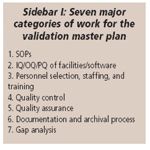
Sidebar I: Seven major categories of work for the validation master plan
We recommend treating a spirit-of-GLP laboratory as you would a non-GLP laboratory to convert it to full GLP status. To begin constructing a new GLP facility, we suggest you first put into effect a master plan (Sidebar I). The master plan should address these major categories of work, with each category assigned its own manager and allocated its own resources:
- Standard operating procedures
- Installation, operational, and performance qualification (IQ, OQ, and PQ, respectively) of facilities, instrumentation, and software
- Personnel selection, staffing, and training
- Quality control (QC) procedures and staffing
- Quality assurance
- Procedures and staffing
- Documentation and archival process
- Final gap analysis.
The SOPs
The standard operating procedure (SOP) is a good starting point for discussing each of the master plan's components. Sponsors hold an advantage over the contract laboratory with respect to their ability to clearly define a philosophy for the group. In contrast, contract research organizations (CROs) must accommodate the competing philosophies of a diverse customer base at minimal cost. So sponsors find themselves at a competitive advantage because they can adopt a specific strategy to pursue the approach they regard as the most compliant and effective for the laboratory. This advantage should manifest itself in the SOPs. We advocate a strongly minimalist philosophy and a core team of GLP-seasoned individuals to write the SOPs. We viewed the SOPs as a layered pyramid with each layer providing a foundation for the higher-level SOPs (Figure 1). In the bioanalytical laboratory, the actual work products are method validations and sample analyses. The highest level SOPs that detail oversight of all the processes are the documentation and quality control SOPs.
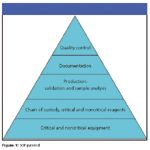
Figure 1
A desire to keep the SOPs as simple as possible, and all nonregulatory detail restricted to business practice rather than legislation, characterizes the minimalist philosophy. Absent a scientific basis, guidance, FDA Form 483, regulatory code, or other (regulatory) reason for a procedure, business practice, not SOPs, should govern work procedures. The SOPs should be unequivocal documents written for simplicity and easy remembering. That said, the minimalist philosophy should be tempered by a desire to eliminate all possible errors while being able to attack issues in a thorough, reconstructable manner. Sidebar II lists and describes briefly the SOPs we recommend addressing immediately.
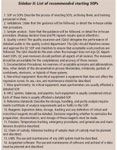
Sidebar II: List of recommended starting SOPs
IQ/OQ/PQ: Separate Facilities are Best for New Labs
We cannot overstate our recommendation for a physically separate laboratory or work area when building or rebuilding a GLP bioanalytical laboratory. A separate facility obviates the often unnecessary requirement to validate a discovery infrastructure and the additional overhead of establishing GLP procedures, such as strict labeling, for discovery work. By adopting this approach, we were able to minimize the scope of the initial IQ/OQ/PQ validation work to only two instrumentation systems and three freezers in our initial rollout of the GLP facility.
Hire external partners: At a reasonable cost, you can purchase audit-proven protocols and processes from external consultants. We hired external consultants for significant portions of our IQ/OQ/PQ. These partners provided a draft protocol and on-site assistance for the IQ/OQ/PQ execution, which our staff performed.
Personnel Management and Recruiting
GLP work represents the public and repeatable foundation for a new drug entity's safety margin. The validated exposures of a drug in an animal model establish the threshold of highest tolerable dose. The difference in this exposure and the dose anticipated to demonstrate efficacy is the basis of the safety margin, the therapeutic index. The work of personnel who perform GLP bioanalyses represents a critical component of the entire organization's assessment of safety margin. That work must be unassailable. If necessary, it must be able to withstand scrutiny in a court of law. Training documentation for analysts must emphasize the importance of this work and specifically warn against any sort of fraud, back-dating, or reporting false quality-control (QC) results. This might seem obvious, but you must anticipate and plan for preventing the weakest of defenses: "I wasn't trained," "I was rushed," or "I didn't have proper resources." On a more positive note, an analyst's ability to perform GLP-quality work is a mark of distinction. It provides breadth to a résumé and proves the analyst able to give a remarkable degree of attention to details and quality. It also offers him or her significant professional satisfaction: the ability to produce a highly refined bioanalytical method, as opposed to the fast, generic methods seen in the discovery phase of drug design. You should seek analysts who understand the accountability associated with GLP work, its intrinsic importance, and the personal opportunities it affords.
QC: Accountability Pyramid
In the accountability pyramid (Figure 2), Each step is 100% accountable for any errors or omissions determined by the subsequent step. However, each subsequent step is responsible for providing oversight to ensure that reasonable procedures are utilized by the proceeding step. A management team retains overreaching accountability for each step.
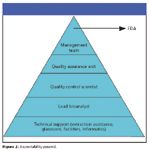
Figure 2
We found that even for a relatively small facility, true 100% QC combined with metrics tracking, outsourcing management, SOP training, and SOP revisions justifies the services of a full-time employee. We adopted a model in which a QC scientist, wherever possible, maintains a checklist system approved by a quality assurance unit (QAU) and other procedures to maintain documentation, chromatograms, electronic archival resources, and all other QC mechanisms for the work. We highly recommend you do the same, creating a dedicated resource for this function and staffing it with an experienced GLP bioanalyst whose sense of the urgency and necessity of performing unassailable bioanalytical work is fully developed. Management is responsible for ensuring adequate staffing for proper surveillance of the work, as stated in the preamble to the 1987 GLP regulations. If the QAU is able to deliver 100% QC service by retaining an experienced analyst whose time is fully dedicated to QC activities (as perhaps originally envisioned in the preamble and code), then doing so would suffice. Nevertheless, to maintain a connection to the process we recommend the QC scientist perform some amount of bench work in addition to his or her QC responsibilities. Further recommendations for quality control measures are delineated in the following section
Electronic Records
We recommend you develop a strict file nomenclature and include this task as a line item in a QC checklist to follow when reconstructing electronic data. Accepted and rejected runs should be indexed in the paper data, and any reinjections also should be indexed and explained.
While many well-characterized chromatographic software systems have evolved to a highly "validatable" state this is not always true of software developed to control mass spectrometers and other instruments in the laboratory that produce GLP-defined raw data. Electronic raw data also require specific archival procedures that are somewhat less established. For example, you might consider this approach:
- Creating a new subdirectory for each run
- Acquiring the data
- Transferring the entire subdirectory into a validated, write-once, read-only, share drive
- Verifying and documenting that the data are retrievable and viewable.
With such a system, you can protect the data against hard-drive crashes and define a final version of the integrated data. Also, because the data are read-only, they are protected against corruption. We recommend this system or a similar one that relies on indelible media such as CD-ROM storage. An article appearing in this column on "The High-Speed State of Information and Data Management" (2) is worth a look on this topic because there are numerous decisions to be made depending upon such things as archival needs (how long must data be maintained) and at what level of access.
Chromatogram Review
Acceptance of chromatographic quality remains a subjective assessment. The director of the facility should approve a detailed guidance on chromatographic quality, and QC scientists should be prepared to implement this subjective guidance.
Integration Parameters
Current acquisition software makes it clear to an auditor whether different integration methods are applied during the course of a run. Whether it is preferable to improve baselines via individual integrations or objectively draw them using the same integration methods for all samples is a matter for legitimate debate. We adopted the latter approach (automated baselines only) and recommend it as more objective and unassailable than a subjective system and less open to abuse. We also recommend that chromatograms using manual or altered parameters are printed both ways and approved by the functional manager, who is usually the facility director. Relying on archived, secured, electronic, raw data facilitates the QC review and auditing of integration parameters.
Quality Assurance
All GLP work requires a protocol, a study director, and a QAU. Without a QAU, a GLP group cannot exist. When drafting the master plan to build a GLP bioanalytical laboratory, the need to adequately staff the quality assurance unit is sometimes underestimated. The firm contemplating building or rebuilding the laboratory often tries to combine this new work function with its existing in-life GLP or good manufacturing practices (GMPs) regulatory groups. We do not support this approach. GLP bioanalysis requires complex and highly cross-referenced documentation, and its regulatory environment is fast evolving. Form 483s and guidances are highly technical and require a focused effort to capture in an applied audit. If resources are limited, alternatives to hiring a new auditor exist, but we do not recommend avoiding the hire by appointing a GMP or in-life GLP auditor in an "overtime" scenario.
In the 1987 GLP preamble, the FDA makes two important statements. The first is that the QAU auditor can be any scientist not involved in the study, and the second is that audits must be made in a timely fashion so that correction can be made. We interpret this to indicate that the agency recognizes that some firms lack sufficient resources to recruit new employees for the QAU position. You might therefore staff QAU positions with existing employees, provided those employees are not involved in a current study. This is a far cry from the level of separation often called for by QAU groups. As applied today, the industry trend calls for the QAU to report directly to the senior council rather than the department head. This minimizes conflicts-of-interest, insulates the auditor from the work, and provides each auditor with an enhanced career opportunity to audit multiple areas of work: GMP, GLP in-life, GMP dose formulations, GLP Bioanalysis. However, it limits the specialization of the auditor in highly complex and increasingly specialized technical applications. We are not against centralized QAU groups or generalist models per se. Yet we strongly recommend that the QAU be adequately staffed to enable satisfactory specialization and turnaround time to support a new lab, requirements that might supersede a few additional layers of independence or auditor career track.
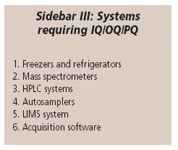
Sidebar III: Systems requiring IQ/OQ/PQ
Audit turnaround time, a critical issue for all organizations, is particularly critical for a new laboratory. An audit of several months' delay could catastrophically affect a new group. If the QAU group takes several months to return its audit of a single study while a new group continues to produce several studies' worth of data, the QAU would, in so doing, place the entire organization at risk of regulatory noncompliance. For lack of feedback, the resultant safety margin data for the several studies produced would all potentially contain the same flaws as the first study. Millennium's QAU committed from the beginning to achieve very short turnaround times for each component of the work it audited for the new group, including a run-to-run data review. We believe speedy turnarounds are becoming standard for contract research organizations (CROs) and throughout the industry. Indeed, the 1987 preamble to the GLPs states that audits "must be conducted in a timely fashion so that corrections can be made." As the accepted time for the making of corrections becomes shorter, the need for fast audits becomes more pressing. To fulfill this need when internal resources are unavailable, you can outsource the work to one of the many organizations that provide auditing services. Alternatively, as allowed for in the 1987 preamble, you can adopt a peer audit model whose participants are not involved in the study.
Before rolling out a new group, we recommend that you engage an external auditor to perform a full gap analysis. For this, you should choose an individual consultant or firm specializing only in quality assurance. Many CROs see internal laboratories as competitors or customers and so, either way, have a conflict of interest in performing the gap analysis. Other useful information can be found in government publications (3,4).
Documentation and Archival Processes
Sidebar IV offers a summary of key considerations for the documentation system. We used a three-ring binder system to file the approved, official, tracked forms issued by our documentation group. In addition, we added an SOP for a rigorous file nomenclature and archival system to facilitate the use of electronic raw data. We elected to use protocols to drive our validation, and a portion of the validation report constitutes a bioanalytical procedure used during sample analysis.
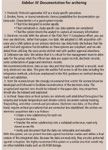
Sidebar IV: Documentation for archiving
Conclusion
We have presented here for discussion within the community the high-level details of a master plan that we followed to build and roll out a GLP facility at Millennium Pharmaceuticals. We believe these recommendations should serve as a useful tool to facilitate building a quality facility for performing this important work.
Acknowledgments
The authors would like to thank the other members of the team that built the Millennium Pharmaceuticals GLP facility with them, particularly Cheryl Riel, Ann Chernosky, John Brown, Eyal Wulz, and Becca Greenberg, and the management team, Gerald Miwa and Peter Smith.
"MS — The Practical Art" Editor Michael P. Balogh is principal scientist, LC–MS technology development, at Waters Corp. (Milford, Massachusetts); an adjunct professor and visiting scientist at Roger Williams University (Bristol, Rhode Island); and a member of LCGC's editorial advisory board.

Michael P. Balogh
Adam Brockman began his industrial career as a scientist at Covance Laboratories in their GLP LC-MS/MS facility in Madison Wisconsin. Following this initiation into G(X)P bioanalysis, Dr. Brockman joined Pfizer Groton to head a high throughput ADME screening laboratory where, in addition to his contributions there, he subsequently helped to rebuild a GLP bioanalytical facility. He then brought the benefits of both of those experiences to Millennium Pharmaceuticals, where he built both new GLP and HT-ADME facilities. Now at Merck Boston, he is working in a generalist DMPK group supporting the broad needs of Discovery project teams.
Jing-Tao Wu received the Ph.D. degree in Analytical Chemistry from the University of Michigan. He is the Director and the head of the bioanalytical group in the Drug Metabolism and Pharmacokinetics Department of Millennium Pharmaceuticals, Inc. In this role, he leads the bioanalytical group to provide mass spectrometry based bioanalytical support for all discovery and development projects. Before joining Millennium, Jing-Tao worked in the DMPK Department of DuPont Pharmaceuticals as a Senior Research Scientist. He has published nearly 40 papers in peer reviewed journals in the field of bioanalytical mass spectrometry.
References
(1) M.P. Balogh, LCGC 22(9), 890–894 (2004).
(2) M.P. Balogh, LCGC 23(6), 576–584 (2005).
(3) 21 CFR Part 58, OECD Principals of Good Laboratory Practice.
(4) Guidance for Industry: Bioanalytical Method Validation, U.S. Department of Health and Human Services, FDA, CDER, CVM, May 2001.
Modernizing, Managing, and Complying with Regulatory Advances in Science
November 17th 2016Change, while scary, is a necessity. Opportunities for increased efficiency, higher profitability, and the ability for an organization to maintain a competitive advantage necessitate the need for change. Correctly adopting new liquid chromatography (LC) technology can be very challenging, however, when done correctly, modern LC technology can give a laboratory the ability to simplify method transfer across a diversity of analytical LC platforms at all of its facilities.
